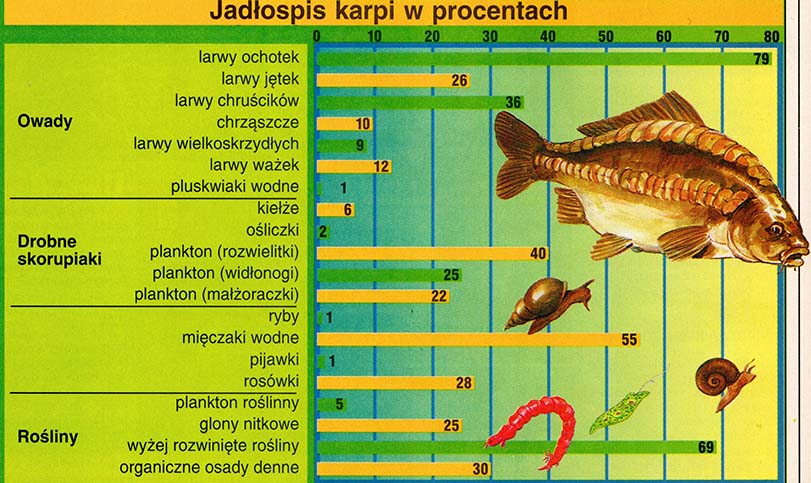 Francuscy ichtiobiolodzy przebadali zawartość żołądków 1398 karpi z wód stojących. Przeczytajcie, co ryby te najchętniej zjadają.
Francuscy ichtiobiolodzy przebadali zawartość żołądków 1398 karpi z wód stojących. Przeczytajcie, co ryby te najchętniej zjadają.
Karpie nie są, jak wcześniej sądzono, typowymi roślinożercami. Najnowsze badania dowodzą, że są wszystkożerne i wykazują szczególne upodobanie do zjadania pokarmu zwierzęcego. Pokarm pochodzenia zwierzęcego stanowi niekiedy od 75 do 95 procent całego zapotrzebowania pokarmowego karpi. Karpie są aktywne pokarmowo głównie nocą oraz wcześnie rano i pod wieczór. Podobnie jak inne ryby spokojnego żeru, najwięcej pokarmu zjadają latem. Zimą lub późną jesienią, gdy temperatura wody spada poniżej 10 stopni, zapotrzebowanie pokarmowe karpi wyraźnie maleje. W wodzie o temperaturze poniżej 6 stopni karpie przestają prawie w ogóle żerować.
Dafnie w żołądku
Wiosną bardzo ważną pozycją w jadłospisie karpi jest plankton zwierzęcy. Odżywiają się nim wszystkie dorosłe ryby, jednak rzadko kiedy plankton zwierzęcy stanowi więcej niż 10 procent całej masy pokarmowej. Zoo-plankton należy więc traktować jedynie jako uzupełnienie głównego pokarmu, co nie zmienia jednak faktu, że niektóre trzyletnie karpie potrafią dziennie zjeść nawet do 600 g dafni (rozwielitek). Co prawda latem w żołądkach karpi znajdowano już dużo roślin (przeważnie wyżej rozwiniętych, liściastych), jednak pokarm roślinny nie stanowi głównego pożywienia karpi. Jedynie podczas letnich upałów karpie czasami napychają sobie żołądki tylko roślinami, jednak w pozostałych porach roku pożywienie pochodzenia roślinnego rzadko kiedy stanowi więcej niż 10 procent całkowitej masy pokarmowej zjadanej przez ryby. Zjadanie dużej ilości pokarmu roślinnego można wytłumaczyć też niedoborem naturalnego pokarmu zwierzęcego w wodzie. Należy jednak zaznaczyć, że z wyjątkiem amurów, prawie żaden inny gatunek ryb nie zjada tak dużo roślin, jak karpie. Głównym składnikiem pożywienia karpi są larwy ochotek. Obecność ochotek stwierdzono w żołądkach 8, na 10 przebadanych karpi. Larwy te stanowią około jednej czwartej całego pokarmu zjadanego przez karpie. Larwy ochotek żyją w osadach resztek organicznych rozkładających się na dnie. Żerujące karpie często wciągają do pysków (razem z ochotkami) butwiejące części roślin i połykają je. W jednym litrze rozkładających się resztek roślinnych można doliczyć się czasami nawet do 4.000 sztuk larw ochotek. Wyjaśnia to, dlaczego obydwa te rodzaje pożywienia tak często i w tak dużych ilościach znajdowane są w żołądkach karpi. Karpie należą do nielicznych ryb dennych, które szukają pożywienia w mule nawet przy bardzo niskiej zawartości tlenu w wodzie.
Ochota na larwy
Zaraz po larwach ochotek, ulubionym pokarmem karpi są wodne ślimaki oraz inne małe mięczaki. Pokarm ten znajdowano przeważnie w żołądkach dorosłych ryb, jednak, gdy ochotki stanowiły co najwyżej jedną czwartą objętości badanej treści pokarmowej, drobne mięczaki wodne wypełniały żołądki ryb nawet w 45 procentach. Latem oraz jesienią ślimaki i drobne małże w wielu przypadkach stanowiły główną masę treści pokarmowej badanych karpi.
Od czasu do czasu w menu karpi znajdują się także inne larwy owadów, głównie jętek i chruścików. Karpie nie gardzą także larwami ważek, pokarmem zjadanym tylko przez nieliczne gatunki ryb. W żołądkach jednej trzeciej przebadanych karpi stwierdzono też resztki rosówek. Rosówki stanowią ważny składnik naturalnego pokarmu karpi głównie wiosną i zimą.
Zadziwiające okazało się natomiast znalezienie w żołądkach karpi ziaren zbóż. Naukowcy stwierdzili obecność ziaren kukurydzy i innych drobnych nasion w żołądkach ponad 90 procent przebadanych ryb.
Karpie rzadko kiedy przejawiają skłonności do drapieżniczego trybu życia.
Wylęg ryb spokojnego żeru znajdowano w żołądkach karpi jedynie sporadycznie, głównie u karpi pochodzących ze zbiorników ubogich w pokarm naturalny, za to z dużą ilością drobnicy.
 Wyniki badań zawartości żołądków 1.400 karpi z francuskich jezior. Tabela obrazuje procentowe ilości ryb, u których znaleziono w żołądkach przynajmniej śladowe ilości danego rodzaju pokarmu. Przykładowo u 79 karpi, na 100 przebadanych, stwierdzono w trawionej treści żołądka obecność larw ochotek. Małe ryby naukowcy znaleźli jedynie w żołądkach stu karpi.
Wyniki badań zawartości żołądków 1.400 karpi z francuskich jezior. Tabela obrazuje procentowe ilości ryb, u których znaleziono w żołądkach przynajmniej śladowe ilości danego rodzaju pokarmu. Przykładowo u 79 karpi, na 100 przebadanych, stwierdzono w trawionej treści żołądka obecność larw ochotek. Małe ryby naukowcy znaleźli jedynie w żołądkach stu karpi.